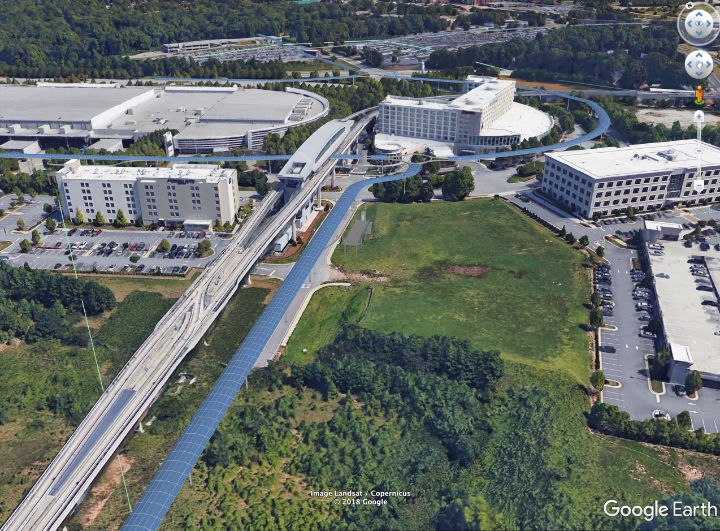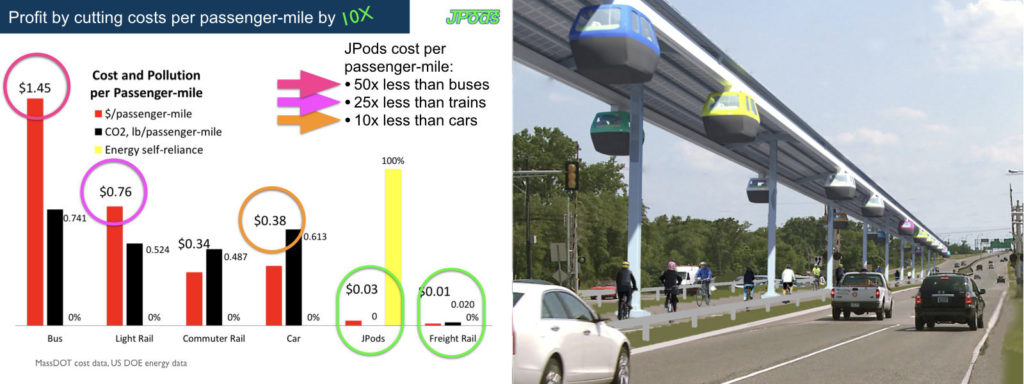Reference: ATLANTA’S TRANSPORTATION PLAN
CHALLENGES
THE GOALS OF ATLANTA’S TRANSPORTATION PLAN ADDRESS THE CHALLENGES WE FACE AS A CITY.
- UNEVEN OPPORTUNITIES AND BURDENS
Some neighborhoods are frustrated by growth and the traffic that has come with it. Others are frustrated by the lack of basic amenities like sidewalks, grocery stores and community services that often accompany growth.
- People have good reasons to be unhappy with traffic:
- Atlantic Monthly: Americans Shouldn’t Have to Drive, but the Law Insists on It
- The automobile/oil-based economy requires families to own 1.97 cars to be economically competitive at a typical cost of $8,558/car/year. This is highly inequitable to the young and the poor. Mobility is the physical manifestation of liberty. Without mobility, aspects of exchange in life such as jobs and education are denied. The “pursuit” of happiness requires mobility.
- Solutions will come from designing cities to be like theme parks which are designed around pedestrians instead of automobiles. See the 5X5 Standard in the actions section.
- What JPods can do to help:
-
- JPods Networks provide on-demand freight services to level the economic playing field for local grocery stores, garage startups, home business, etc. Mom&Pop companies can have logistics equity with Walmart. Substantial self-employment opportunities are created by equalizing access to logistics resources.
- Put protected bike paths under JPods networks and cities become walkable and bikeable. JPods networks will light and provide security for such paths. Our estimate is that 70% of the solution to building sustainable cities is to make them walkable and bikeable.
-
- Understand the fundamental Systems Engineering failure of the car/oil economy. West Point’s Systems Engineering text:
“In fact, one of the most significant failings of the current U.S. transportation system is that the automobile was never thought of as being part of a system until recently. It was developed and introduced during a period that saw the automobile as a standalone technology largely replacing the horse and carriage. So long as it outperformed the previous equine technology, it was considered a success.
This success is not nearly so apparent if the automobile is examined from a systems thinking perspective. In that guise, it has managed to fail miserably across a host of dimensions. Many of these can be observed in any major US city today: oversized cars and trucks negotiating tight roads and streets, bridges and tunnels incapable of handling daily traffic density, insufficient parking, poor air quality induced in areas where regional air circulation geography restricts free flow of wind, a distribution of the working population to suburban locations necessitating automobile transportation, and so on.
Had the automobile been developed as a multilateral system interconnected with urban (and rural) transportation networks and environmental systems, U.S. cities would be in a much different situation than they find themselves in today.
What is important here is not that the automobile could have been developed differently, but that in choosing to design, develop and deploy the automobile as a stand alone technology, a host of complementary transportation solutions to replace the horse and buggy were not considered.”
-
- Oil-wars since 1991 caused West Pointers to design solar-powered mobility networks to end the foreign oil addiction – an action called for by eight Presidents to honor the sacrifice of soldiers who bought time to end that addiction and to defend liberty for Posterity. We can “hold our future in our hands alone.”
John Steward’s observation on our failure to exercise the self-discipline to be energy self-reliant:
-
- JPods wants to invest $4-6 billion in Atlanta over the next 4 years to build US Patent 6,810,817, the Physical Internet®. JPods investing will encourage Hyperloops, SkyTran, and others to invest in Atlanta as well. JPods Networks use their distributed nature to harvest the solar energy to power themselves. Links to five years of data on our collection systems and collectors that our team manufactures in NY.
- UNPREPAREDNESS FOR GROWTH
Many neighborhoods experiencing growth do not yet have the travel options they require to effectively accommodate more people.
-
- JPods are grade separated. They do not compete with the existing use of the ground plane.
- Each automobile requires 3.4 to 8 parking spaces. JPods Networks allow for growth without consuming real estate.
- UNSAFE CONDITIONS
It is simply more dangerous to travel in some parts of the city than others, particularly for pedestrians, bicyclists, senior citizens, people with disabilities, and children.
-
- JPods use the Georgia Fire Safety Standard with 0.2 injuries per million versus 11,200 injuries per million on roads. Cities should can be as safe as theme parks.
- The Personal Rapid Transit network in Morgantown, WV was self-regulated by between 1972-2015, producing 150 million injury-free passenger-miles in the process. In that same period, 1.8 million Americans died on our roads.
- Bike riders in the US are 4 times more likely to be killed than bike riders in Europe. This discourages bike riding.
- OPPORTUNITIES FOR BETTER PROJECT DELIVERY
Several departments and agencies are currently responsible for implementing transportation projects. This can lead to project delays and coordination challenges.
-
- “Skin-in-the-game.” JPods Networks are privately funded so if we fail to deliver on-time, we lose our company to the bankers.
- JPods & the Georgia Mobility Company have extensive experience in significant technology developments and logistics:
- Charlie Fletcher was the Commanding General for Corps Logististics for the invasion of Iraq and the Army’s Transportation Command.
- Mike Teske built over 110 major theme park rides for Disney and Universal Studios.
- Mike Cassano is on the credits for the encryption of BitCoin.
- Ron Swenson has been installing solar collection systems for 40 years and Swenson Builders are major real estate developers in the Silicon Valley.
- Frank Pao is a leading innovator and manufacturer of solar collectors. His entry won the international Net Zero competition held in conjunction with the Beijing Olympics.
- Bill James is a West Point graduate who founded ASI Datamyte to digitize the Just-in-Time manufacturing system. He wrote business software, was invited by Apple on two national tours and patented the Physical Internet®.
- Based on JPods’ long efforts and Senator Beach’s Letter on Feb 12, Goldman Sachs issued a Letter of High Interest relative to investing $4-6 billion in Atlanta in the next 4 years on March 20.
- EXPENSIVE TRAVEL
Without other viable transportation options, people spend more time and money on driving to get around.
-
- JPods Networks will radically increase the value of MARTA by cross-connecting and amplifying the value of existing nodes.
-
- JPods Networks remove the repetitive start-stops and parasitic mass of burning energy moving two tons to move a person. This results in combining the 400 ton-mpg efficiency of freight railroads with the on-demand service of the Internet.
ACTIONS
Aside from the actions of the City’s plan, the following actions are recommended:
- Adopt the 5X5 Standard (as pending in the Massachusetts Legislature, S.1993):
- Privately funded networks
- 5 times more efficient than roads
- Pay 5% of gross revenues for non-exclusive use of Public Rights of Way
This creates an invitation to Hyperloops, SkyTran, and any other local or remote innovators to invest in a development and deployment effort in Atlanta. Some city will become the “Detroit” or “Silicon Valley” of the Physical Internet®.
Some 50 cities chased Amazon to locate a second headquarters in their city. Becoming the economic center of the Physical Internet® is a far larger economic opportunity. Traffic costs Americans $1.7 trillion/year, and the world market for traffic solutions is 5 times larger.
Industries cluster around first builds.

- Host a conference of all industry innovators, inviting them to help create the standards for digitizing mobility. Currently, the scooters, Ubers, and Tesla self-driving cars are operating as “Pirates/Patriots.” They purposefully violate laws using popular support and better services to force changes via common law. Atlanta embracing and leading the digitiziation of mobility may capture the economic center of a multi-trillion-dollar industry.
- Tesla owners have driven 1 billion miles with Autopilot activated
- Full Self-Driving
- First Look At an UNRELEASED Version of a Self-Driving TESLA
- This technology is 47 years old and radically safer when used on grade-separated guideways such as JPods and Morgantown’s PRT. Morgantown has been self-regulated for all but the last 4 years. It was injury-free while self-regulated but saw two injuries in 2016 when regulated by Federal railroad regulations.
- Implement an “environmental hackers” program similar to the mechanisms that created the Personal Computer industry. Provide free downloadable software to design sustainable infrastructure, Empowering Everyone™ to solve traffic problems as they see them. Link to download.
By adopting the 5X5 Standard, all vendors would also provide similar tools to develop, find, and hire talent. Examples of JPods software:
- Route-Time™
- JPods3D – Supports designing networks for integration into Geotech databases for managing construction.
And render images into GoogleEarth.

- Scale model JPods networks that anyone can 3D print.
We can create the labor force of the future by giving them the tools.







